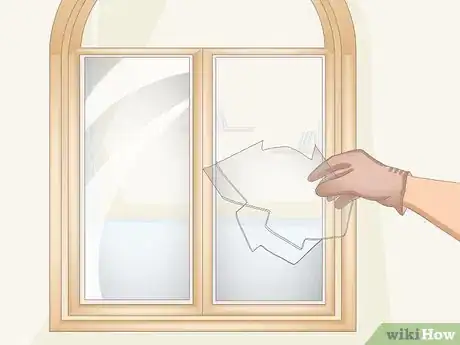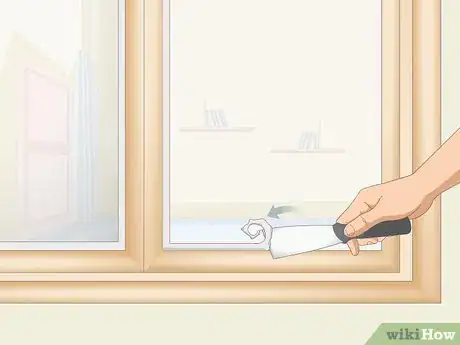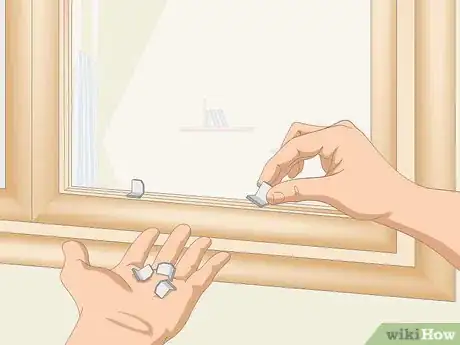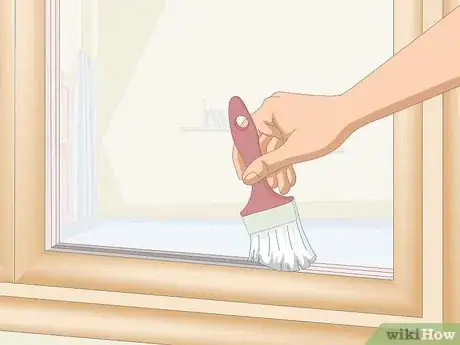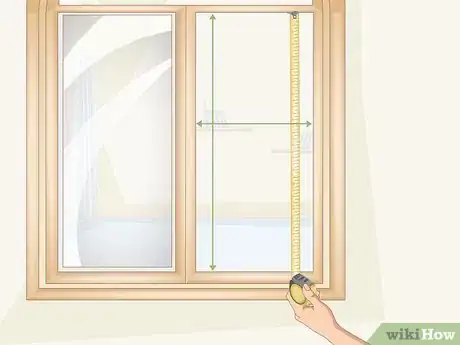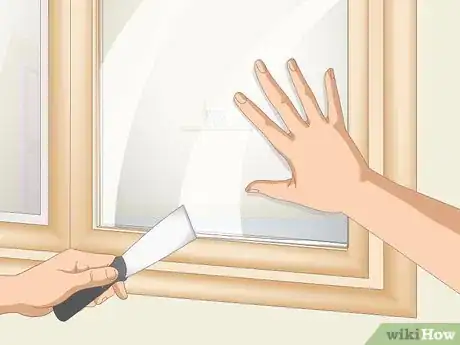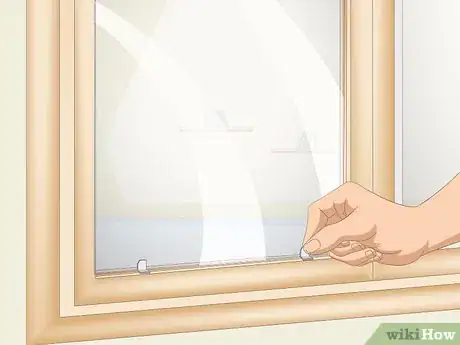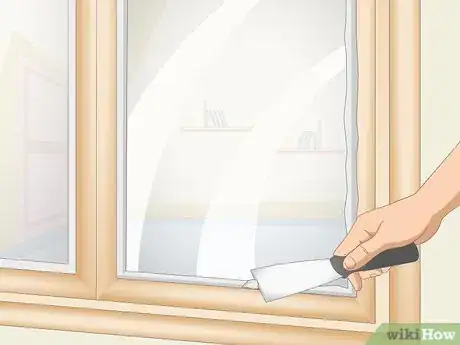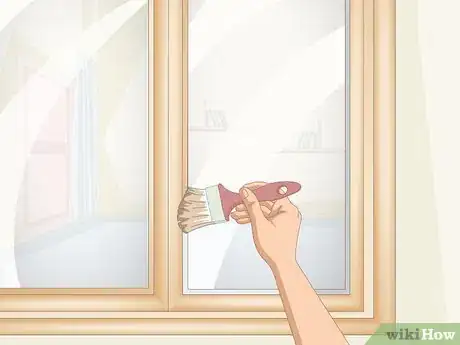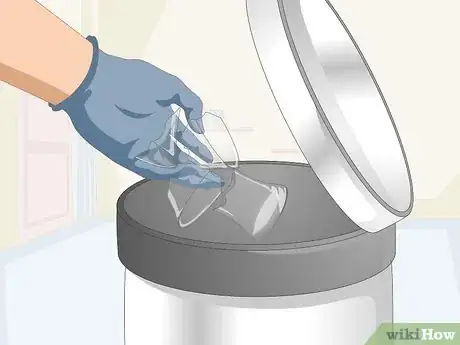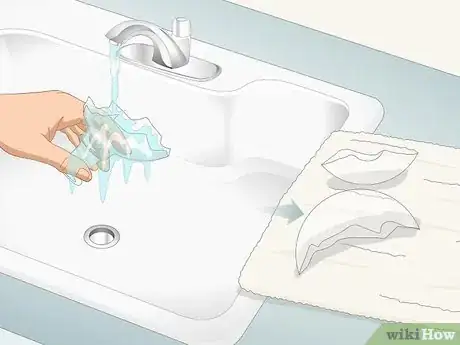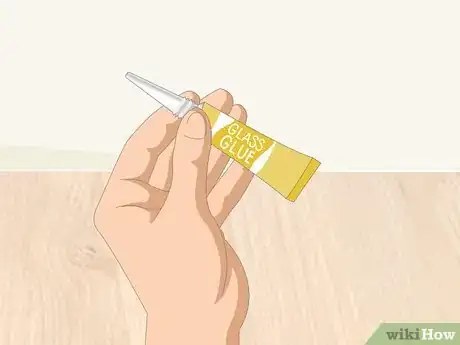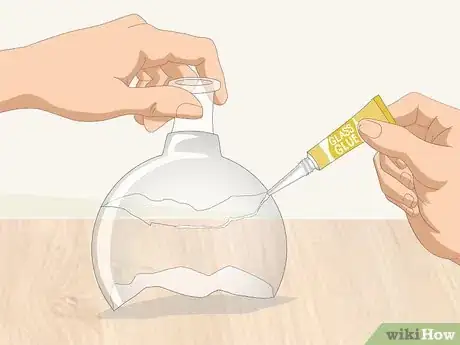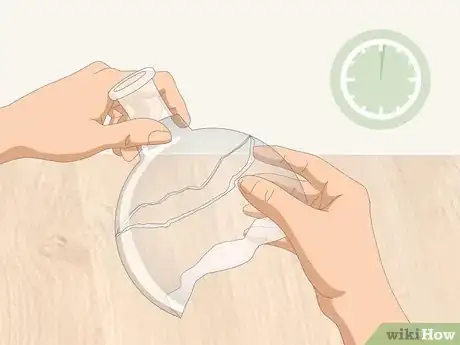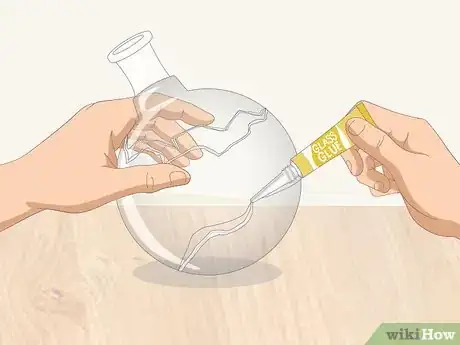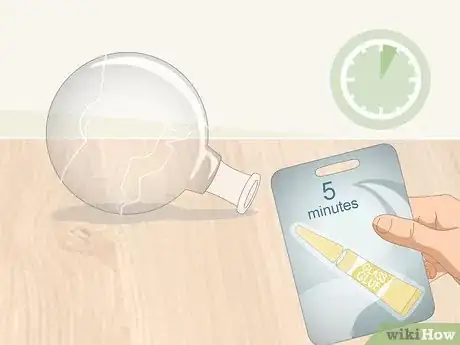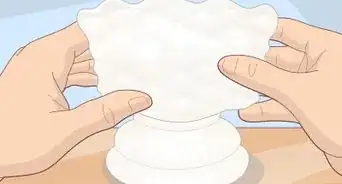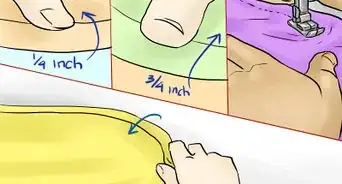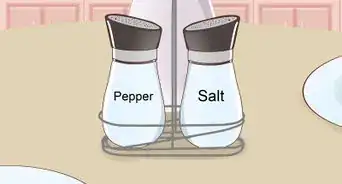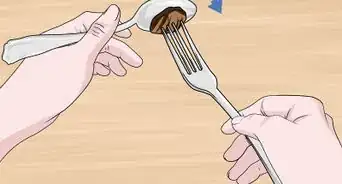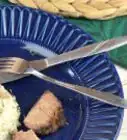X
This article was co-authored by wikiHow Staff. Our trained team of editors and researchers validate articles for accuracy and comprehensiveness. wikiHow's Content Management Team carefully monitors the work from our editorial staff to ensure that each article is backed by trusted research and meets our high quality standards.
There are 17 references cited in this article, which can be found at the bottom of the page.
This article has been viewed 28,485 times.
Learn more...
Broken glass is a bummer, but often you can fix it. For a broken window, remove the old broken glass and replace it with a new windowpane. If you broke glassware, like a wine glass or a vase, you may be able to glue it back together.
Steps
Method 1
Method 1 of 2:
Replacing a Broken Window Pane
-
1Remove the broken pane from the window. Wear leather gloves and safety glasses to protect yourself. It may help to use pliers to pull out pieces of glass that are still in the window frame. Dispose of the broken glass pieces in a cardboard box, because they will tear through plastic trash bags.[1]
- Make sure there are no kids around as you do this step, so the glass doesn’t hurt them.
-
2Scrape off the putty with a putty knife and heat gun. Chisel off the old putty (also called caulk or glazing) that’s around the inside edge of the window frame with a putty knife. Use a heat gun to help soften the putty if you have trouble scraping it off. Wear leather gloves to protect your hands from the heat gun. With the gun in one hand, move it steadily along so you don’t concentrate heat on one spot for too long.[2]
- Discard the putty, because you will need to reglaze with new putty when you put in the new pane.
Advertisement -
3Save all the clips or glazier points. As you remove the putty, you will come across spring clips in metal frame or glazier points in wooden frames. Keep them so that you can use them for the new window pane.[3]
- Put the clips or points in a bowl or jar so that you don’t lose track of them.
- Remember the location so you can put them back near the same spot.
-
4Prime the frame if it’s made of wood. Metal window frames will generally hold up pretty well, but if you have a wood frame, the process of scraping out the putty will most likely scrape the frame a bit. Use a shellac-based primer and paint it on the inside of the window frame. Let the primer dry before you replace the glass.[4]
- Different kinds of primers have different drying times, so check the instructions on your primer.
-
5Measure the frame and buy a new pane of glass. Measure the window frame using a yardstick to determine the dimensions of the glass. Measure from inside edge to inside edge. Buy a glass pane that is 0.25 inches (0.64 cm) smaller than the height and width you measured. Glass expands in heat, which is why you need a slightly smaller pane of glass.[5]
- You can buy glass cut to your specifications at a glass store, hardware store, or online.
- If it’s a storm window, you will need tempered glass.
- If you have a double-paned (also called double-glazed) window, you should probably get professional help to install it.[6]
-
6Lay down a thin layer of putty and put the new pane in the frame. Use an oil-based window putty if you care about having a very smooth result, or a latex window putty if you want it to dry quickly. Set a thin bead of putty inside the frame and put the glass on top. Press the glass down firmly.[7]
- Put the new glass in the frame very carefully to avoid breaking it.
-
7Replace the window clips or glazier points. Press the points into the frame with a putty knife. The glazing points should go in about every 8 inches (20 cm), though it depends on your window frame.[8]
- You don’t need to screw the clips or points into the window, they just wedge between the window and the frame.
-
8Apply new putty between the glass and the frame. Work on the outside of your window, not the inside, because the putty keeps moisture out of your house. Take a glob of putty and roll it around in your hands for a minute until it is warm and an even consistency. Roll it out into a tube and press it lightly along the edge of the window, in the space between the window and the frame.[9]
- Another way to warm up the compound is to set the can inside a bowl of warm water.
- You can find window putty (glazing compound) at hardware stores.
-
9Smooth the putty with a putty knife and let it dry for a week. Press the putty with the putty knife until it is firmly in place and there are no gaps. Rub the surface of the glaze with a long stroke of your putty knife, so that it is smooth. Be extra careful to make sure that there are no gaps in the corners. The putty takes a while to cure, so let it dry for about a week before you repaint the frame.[10]
- If there might be rain, you should protect your window frame so that it doesn’t get wet.[11]
-
10Prime and paint the frame. Paint the frame with a primer, including the new glaze. Let the primer dry fully before you move on to painting. Then, use an exterior paint that matches your other window frames. Carefully paint the entire frame, including the putty. Lap the paint onto the glass about 1/16 in (0.159 cm).[12]
- Check the instructions on your primer to find out drying times. It will often be more than an hour.
- Painting not only looks nice, it also protects your frame.
Advertisement
Method 2
Method 2 of 2:
Gluing Broken Glassware
-
1Discard shattered items. If your glass is broken into a bunch of little pieces, it’s going to be really hard to glue back together. However, if the glass is broken into a few large pieces, it’s worth a shot. Vacuum up the pieces if they are really small, and wipe off any remaining glass dust with a damp rag. Wear gloves when you pick up the large glass shards.[13]
- If glass shattered on the floor, put on shoes to protect your feet while you clean up the pieces.
- If your picture frame or phone screen shattered, replace it.
-
2Clean and dry the glass pieces. Wash the pieces of glass with dishwashing detergent and water, and then dry the pieces off with a clean cloth. If there is any dust or oil on the glass, it won’t stick together as well.[14]
- You can also use a special glass cleaning product if you have one, but you don’t have to.
-
3Get a glass-specific glue. Depending on the kind of glassware, you may need a different kind of glue. Make sure to get a glue that fills your needs, such as heat-resistant, dishwasher-safe, or waterproof. Go to a hardware store, art store, or online to find glass glues.[15]
- Many popular glue brands make glass-specific glues, such as Loctite, Gorilla, and Elmer’s.
- Aquarium glues are strong, but toxic, so don’t use them for items you want to eat off of.
- UV resins work well for clear glass, though they will have to cure in sunlight or under a UV light.
-
4Apply glue to one of the broken edges and line it up with another edge. Wear gloves while gluing the glass. Apply a thin line of glue to one entire broken edge. Line it up with the other broken edge, so that they fit together like puzzle pieces. Glue only two pieces together at a time if your glassware broke into multiple pieces.[16]
- If you’re using an epoxy, you will have to mix it before you apply it.
- Follow the directions on the back of your glue for more specific instructions.
-
5Hold the glass pieces together for at least a minute. Make sure the pieces are properly lined up one more time, and apply gentle pressure to the glass as you hold the two broken pieces together. Some glues require you to hold them for longer, so check the instructions on your glue.[17]
- If you don’t apply pressure, the glue might not bond with both pieces of glass.
-
6Repeat the process with any additional broken pieces. If your glass broke into multiple pieces, you will have to glue them each on separately. Carefully piece together one piece at a time until the whole object is put together.[18]
- Be patient and apply pressure for at least a minute each time you add a new piece.
-
7Let the glue set for the time specified on the packaging. Follow the directions on the glue you are using to figure out how long the glue needs to set. Some set in as little as 5 minutes, while others take a week to fully bond.[19]
- UV resins will need to dry in sunlight or under a UV light.
Advertisement
Warnings
- If your window frame is in an old house and painted with lead, you should ask for professional guidance with the window repair. You don’t want to risk chipping off the lead paint and inhaling it, because lead is toxic.⧼thumbs_response⧽
- Avoid conditions that will harm the glue after you’ve glued your glassware back together. For example, some glues will not withstand heat or water, while others will be fine.[20]⧼thumbs_response⧽
Advertisement
Things You’ll Need
Broken Window
- Safety glasses and leather gloves
- Measuring stick
- Heat gun
- Putty knife
- New window pane
- Window putty (glazing compound/caulk)
Broken Glassware
- Gloves
- Dishwashing Soap
- Glass glue
References
- ↑ https://www.familyhandyman.com/windows/window-repair/how-to-glaze-a-window-single-pane/
- ↑ https://www.familyhandyman.com/windows/window-repair/how-to-glaze-a-window-single-pane/
- ↑ https://youtu.be/SL9Om5pek1A?t=116
- ↑ https://www.familyhandyman.com/windows/window-repair/how-to-glaze-a-window-single-pane/
- ↑ https://youtu.be/SL9Om5pek1A?t=38
- ↑ https://www.thisoldhouse.com/ideas/expert-techniques-reglazing-window
- ↑ https://www.popularmechanics.com/home/interior-projects/how-to/a8043/how-to-reglaze-a-window/
- ↑ https://youtu.be/SL9Om5pek1A?t=145
- ↑ https://www.popularmechanics.com/home/interior-projects/how-to/a8043/how-to-reglaze-a-window/
- ↑ https://www.finehomebuilding.com/2018/01/11/how-to-glaze-a-wood-window
- ↑ https://www.familyhandyman.com/windows/window-repair/how-to-glaze-a-window-single-pane/
- ↑ https://www.popularmechanics.com/home/interior-projects/how-to/a8043/how-to-reglaze-a-window/
- ↑ https://www.bonappetit.com/entertaining-style/pop-culture/article/how-to-clean-up-broken-glass-no-brooms
- ↑ https://www.cookinglight.com/cooking-101/techniques/how-to-clean-wine-glasses-decanter
- ↑ https://youtu.be/SvY5BWoYH7k?t=13
- ↑ https://youtu.be/U1ytb_aVcus?t=113
- ↑ https://youtu.be/SvY5BWoYH7k?t=192
- ↑ https://youtu.be/U1ytb_aVcus?t=243
- ↑ https://youtu.be/U1ytb_aVcus?t=166
- ↑ https://youtu.be/U1ytb_aVcus?t=396
About This Article
Advertisement
